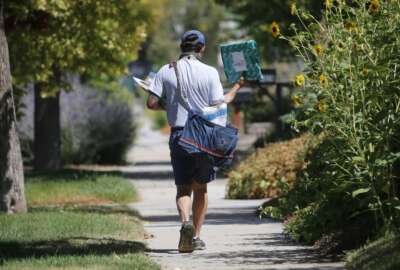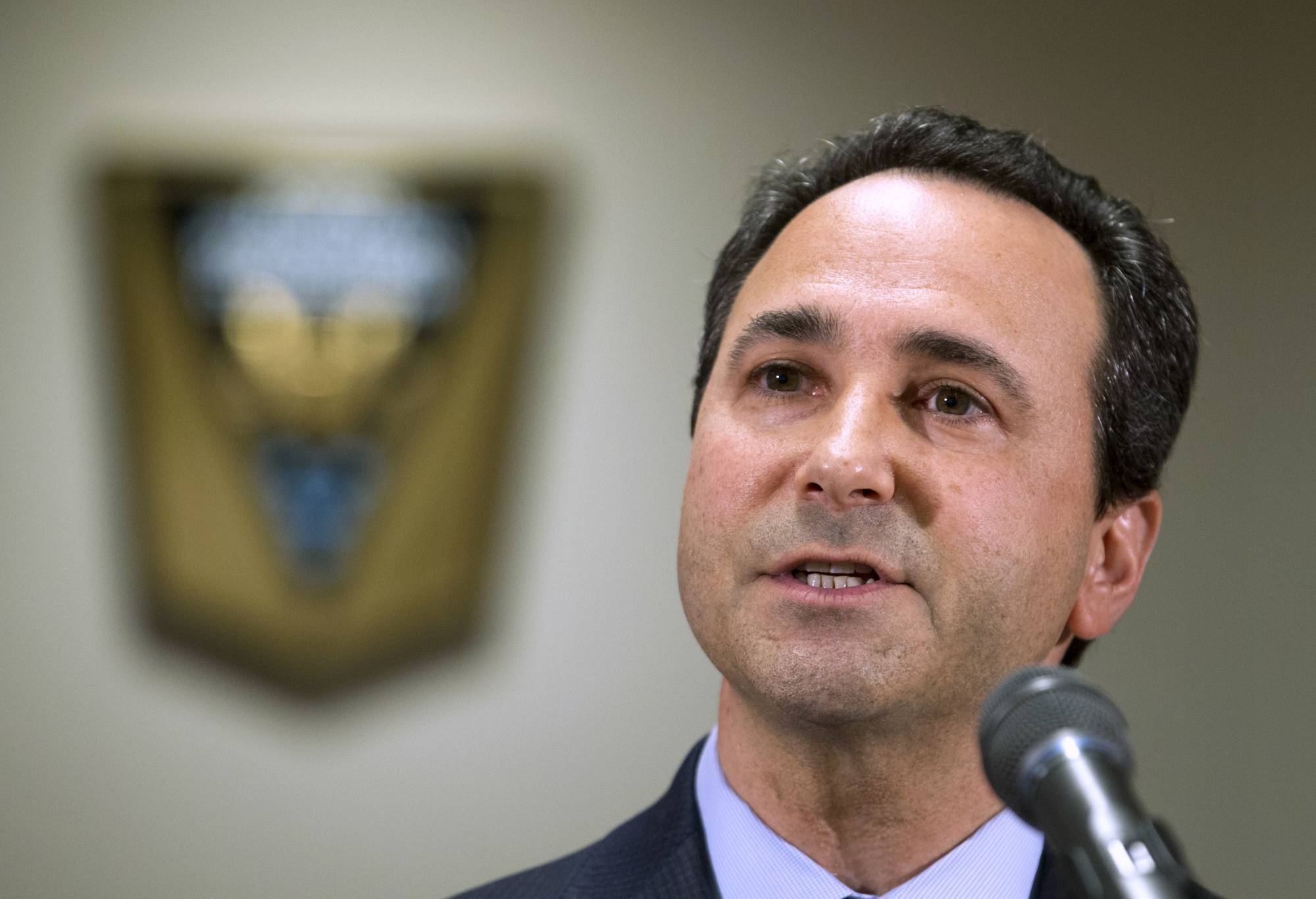USPS trying to keep ‘job-hopping’ new hires to stay for longer term
The Postal Service is rethinking its approach to hiring, with a renewed focus on getting its new hires to stay longer at the agency.
The Postal Service is rethinking its approach to hiring, with a renewed focus on getting its new hires to stay longer at the agency.
USPS, as part of its 10-year reform plan, is trying to reduce turnover and address staffing shortages among its entry-level, pre-career workforce.
Simon Storey, USPS vice president of employee resource management, said the agency made about 142,000 new hires so far this year — about 22% of its total workforce of about 635,000 employees — but that retention of its pre-career workforce remains one of its “single-biggest issues.”
“One of the biggest things that I see with our non-career workforce, right now, is the issue around wanting a job versus wanting a career,” Storey said Tuesday at a summit on labor issues hosted by the USPS Office of Inspector General in Arlington, Virginia. “There’s a lot of job-hopping. And so, our focus has to be continued on retaining the employees that do sign up and come on, and making sure they have a great employee experience, so they stay with us.”
USPS, under its 10-year Delivering for America plan, is looking to cut pre-career employee turnover in half, expedite hiring and improve the overall employee experience.
Storey said USPS is specifically focused on improving the employee experience for new hires, “especially within the first 90 days.”
USPS loses about 40,000 employees a year to attrition. That includes retirements and employees leaving to find work elsewhere.
Postmaster General Louis DeJoy, in an exclusive interview, said in July that USPS may need to hire about 300,000 new employees over the next 10 years just to keep its current workforce headcount.
USPS is trying to rein in turnover among its pre-career workforce, but even in a “best case” scenario, DeJoy estimated that pre-career turnover will still hover around 20%.
“It’s just hard work. You don’t get to go to boot camp, to figure out if you want to come here. You’ve got to go into the place,” he said.
A recent USPS OIG report found that USPS pre-career turnover increased substantially in recent years — from 40% in 2020, to 59% in 2022.
USPS Inspector General Tammy Whitcomb Hull said that based on recent OIG field visits, staffing shortages and inexperienced staff often contribute to regional mail delays.
“Recruiting, hiring and retaining such a large and geographically dispersed workforce is certainly to come with challenges,” Hull said, adding that USPS OIG plans to continue looking into workforce issues in fiscal 2024.
As part of its workforce planning, USPS is rethinking its pitch to younger generations of workers. But like the rest of the federal workforce, the agency faces increased competition from the private sector for entry-level talent.
Ivan Butts, president of the National Association of Postal Supervisors, said that given historically low unemployment rates, USPS finds itself losing candidates to private-sector businesses that can offer better starting pay and better hours.
“That’s impacting us tremendously in the post office, because of the demands on non-career employees coming in to be a carrier, it is a lot,” Butts said. “It’s physical, it’s long hours, it’s kind of demanding. The work is a little strenuous.”
The national unemployment rate currently stands at 3.8%, according to the most recent data from the Bureau of Labor Statistics. Storey said USPS is having a harder time finding candidates in parts of the country where unemployment is lower than the national average.
Meanwhile, Butts said USPS faces additional challenges recruiting Millennials and Gen Z workers.
“They’re more transient in their employment, in the way they look at employment. They look at jobs as being able to fit into their expectations. And if a job doesn’t fit into their expectations, then they leave it,” Butts said. “This new generation, they’re not looking for a career, necessarily. They’re looking for a job that they can work, and that job has to fit into their lifestyle and the things they want to do. And if it doesn’t, then they move on. That’s why we have issues with our retention rates.”
USPS is the second-largest employer in the U.S. The agency is taking steps to reduce its pre-career attrition rate, but Storey said that USPS sees “phenomenal” retention of its career workforce. He said USPS sees a 2.5% to 2.8% monthly attrition rate among its career ranks.
“That’s better than any private-sector retention,” Storey said, adding the USPS career employees stick around for retirement benefits, health care and matching contributions to the Thrift Savings Plan. “You stay with us, you’ve got great benefits, health benefits. You’ve got a good retirement package, plus you have a competitive wage.”
Given increased competition for new hires, USPS is looking to improve the hiring process and shorten the time candidates spend waiting to begin a job.
Storey said USPS took about 57 days to hire and onboard employees in 2021, but reduced that average time-to-hire window down to about 27 days. But he said USPS still loses a “good number of applicants” who are not willing to wait through background checks and security screenings.
“That’s the distinctive difference with a federal entity, versus the private sector. There are some certain standards that we adhere to,” Storey said. “You’ve got to really be reaching out to the candidate, communicating to candidates, keeping their interest in the position, in the career, to keep them in the process, if you will.”
USPS is also moving away from its legacy eCareers hiring system and toward to a more mobile-friendly platform.
“A lot of applicants now with this generation, they’re constantly on their phones,” Storey said. “They like to do everything on their phone, so making it mobile-friendly, that’s a big technology change. We have to consistently look at what technology is available to make a better applicant experience.”
Storey said USPS is also insourcing more of its logistics work, bringing more trucking jobs in-house, rather than relying on contractors for its transportation needs.
USPS isn’t the only federal agency on a hiring spree. The Department of Veterans Affairs has made about 50,000 new hires so far this fiscal year, and is on track to meet or exceed its hiring goals.
VA Chief Human Capital Officer Tracey Therit said the VA is also looking at ways to improve retention among its new hires.
“The last thing you want is to bring on a lot of folks, and to see them leave, and to have that high turnover,” Therit said. “When there’s low supply, high demand, [we’re] making sure that our HR team, our hiring managers and recruiters know how to communicate that value proposition.”
The VA is holding in-person hiring events, where department leaders can make on-the-spot job offers to candidates. It’s also hosted several onboarding events to streamline all the steps candidates need to complete before they start a job.
“We bring people to a facility to get their fingerprints, to get their drug testing, to get their physicals, to get their badging. So in one instance, all of those steps in the process can be completed,” Therit said.
Butts said USPS used to rely on some of the pooled hiring practices that are now more common across the federal government, and that it would see fewer candidates drop out of the hiring process if it streamlined those onboarding steps.
“We would bring all the candidates in, get them fingerprinted, get the drug tests, get all that done, so then you have a pool,” Butts said. “I think that was a better process than we have currently now, when we’re doing a kind of one-at-a-time.”
BLS estimates that USPS, between 2022 and 2032, will need to fill about 34,400 positions each year. But the statistical agency also predicts USPS will need to cut its total workforce by about 8%, or 39,000, over the same period of time.
“The Postal Service likely will need fewer workers because new mail sorting technology can read text and automatically sort, forward, and process mail,” BLS states in its latest job outlook. “The greater use of online services to pay bills and the increased use of online communications should also reduce the need for sorting and processing workers.”
DeJoy said in July that the overall size of the future USPS workforce is subject to change.
“I think the workforce could be about the same, only with more volume and running with greater yields. That is not something I’m worried about trying to aggressively cut,” DeJoy said. “Number one, it’s not the commitment that the organization makes to its workforce. Number two, these are valuable people, trained people that know what we’re doing, [and] are valuable to us. What we need to do is inspire them.”
The size of the USPS workforce, he added, ultimately comes down to how successful the 10-year plan proves in growing the agency’s business.
“Do we get to 700,000 people instead of 600,000 people? It’s not out of the question,” DeJoy said. “In order to be committed to your employees, you have to be successful.”
Copyright © 2025 Federal News Network. All rights reserved. This website is not intended for users located within the European Economic Area.
Jory Heckman is a reporter at Federal News Network covering U.S. Postal Service, IRS, big data and technology issues.
Follow @jheckmanWFED






